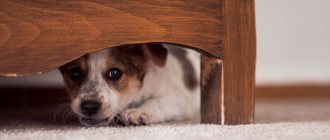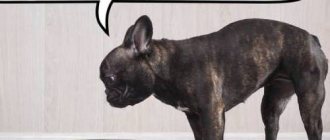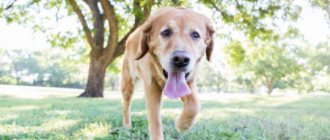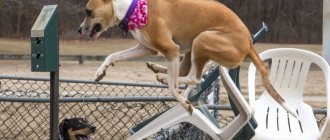Even a completely normal and healthy dog gets scared in certain situations; this is a completely natural reaction. In most cases, the dog, having convinced itself several times that the explosion of firecrackers or thunder does not cause any harm to it, stops reacting to them. The problem arises if the fear persists and puts the animal into a state of panic. Usually the solution to the problem is to train the dog not to be afraid of gunfire. The fact is that if an animal is not afraid of gunshots, then it is not afraid of other sounds - be it thunder, a burst car tire or fireworks. So, let's take a closer look at what causes fears and what to do if the dog is afraid of gunshots, thunderstorms, fireworks and loud sounds in general.
Causes of dog fears
The reasons why a dog is afraid of loud sounds and noise on the street can be very different. Usually it’s all due to psychological trauma, a horror that was once experienced. Too strong an impact to which the dog has been subjected “breaks through the insulation” and an abnormal stable connection arises between certain nerve centers, which manifests itself in all cases when the dog subsequently encounters similar stimuli.
It is not always possible to identify the specific cause of persistent pathological fears . Let's imagine that a puppy was attacked by a large dog, tore out a clump of fur from him and scared him greatly. At the same time, a motorcycle roared past, to which you, carried away by saving the puppy, simply did not pay attention. The puppy may subsequently be afraid of big dogs all his life, or maybe the sound of a motorcycle. There was a case when it turned out that a dog that is afraid of shots is not afraid of the shots themselves. For a long time she was not afraid of loud noises, but one day she was scared by fireworks. As a result, the dog became afraid of gunshots only because he had the belief that gunshots and fireworks were connected. When she hears a shot, she immediately hides under a sofa or bush. That is, the shot became a kind of warning for her that fireworks were about to go off and she needed to urgently hide.
A weak stimulus can “break through isolation” if it acts constantly and each time causes negative sensations in the dog (that is, the dog constantly receives confirmation that this or that phenomenon or object is dangerous). For example, if you punish your pet every time the doorbell rings, the animal may develop a panicky fear of the sound of the bell. Pathological fears can develop due to a weak nervous system in dogs raised in an impoverished or nervous environment.
Operating principle of an ultrasonic repeller
The operating principle of any ultrasonic repeller is based on noise waves that every dog’s ear can detect.
Note! The human ear perceives sounds only up to 20 kHz, but dogs, in turn, perceive sound signals up to 40 kHz.
Repellers predominantly produce sounds that irritate dogs at a frequency of 116 decibels. The included device is capable of operating within a radius of about 30 meters. The greatest efficiency can be achieved with a minimum distance.
What not to do when teaching your dog to loud noises
When starting to work with fears in puppies and adult dogs, it is important to follow the rules:
- Don't try to calm your dog down with hugs or petting! When a dog is scared, the first reaction of a person is to press him and pick him up. These are characteristic reactions of a primate, and they will have an effect on a frightened baby monkey. But a puppy (with the exception of very small ones), much less an adult dog, cannot be calmed in this way. When a dog is very frightened, any physical restriction of movements is perceived as blocking the path to escape, and thereby sharply increases fear. Next to you, the pet may feel a little more confident, perhaps even begin to cuddle up to your legs, but this is just an attempt to protect itself. He does not wait for your hugs; for him, protection is expressed this way - either you shield him from danger, or you attack the enemy.
- Don't pet your dog or give him treats when he's panicking! Verbal praise, stroking and giving treats will be perceived by the animal as approval of the behavior and confirmation that they really need to be afraid. The dog may take food from you, but overall this will only make the situation worse.
- Don't punish the dog! Screaming, pulling the leash or hitting the dog when it is frightened by fireworks, thunder or other sharp sounds is completely unacceptable.
- Do not panic! If your dog is afraid of something that does not pose any real danger, ignore his fear and remain completely calm. Do not let her off the leash if you know that you may encounter “danger” (if your dog is afraid of fireworks, under no circumstances should you walk without a leash on May 9 and New Year’s holidays). If the dog is on a leash, then not only ignore the fear, but also do not give any commands. Your equanimity will show the dog that there is nothing to be afraid of. If the dog is off-leash and runs away, then try to stop it with a loud, calm command (not threatening). Don't try to chase your dog, this will only increase his fear. Calmly follow her, periodically shouting her name in a friendly voice. It is clear that in such a situation the animal can get hit by a car, but chasing with screams will definitely not improve the situation, but on the contrary will increase the chance of an accident.
- Don’t do “shock therapy”! Some owners deliberately expose their dog to “scary” influences. The logic is this: a dog cannot be afraid all the time; it must understand that loud sounds and noise are not harmful. This technique works in very, very rare cases. If a dog has a strong fear of gunfire, then exploding firecrackers under its nose will not cure it of fear, but will turn a simple fear into panic. Continuing training, you have a high chance of crippling the animal’s psyche or killing it. After all, severe stress can kill a dog, just as it kills a person.
How to wean a puppy under 6 months old from “scary” sounds and objects
Small puppies can be afraid of a variety of sounds and objects: clanking carts, rustling bags, a vacuum cleaner, a hairdryer. Fear is usually caused by loud noises and large objects approaching. It is clear that the worst thing is the combination of one with the other. Each puppy has its own fears: for one there is nothing worse than an old lady with a cart, another is frightened by the grinding sound of a suitcase being pulled out from under the sofa. As you grow older, some fears may disappear, while others may appear. Today the puppy looks suspiciously at a passerby with a rustling bag and calmly walks past a crying child; after a few days he stops paying attention to the bags, but begins to shy away from children. So, before 6 months of age, there is no point in specially accustoming a puppy to any things or sounds - the puppy will overcome most of its fears on its own . But you can help him. Among other things, this will strengthen the baby’s trust in the owner.
The basic rule is that if the puppy is afraid of something, you cannot raise your voice at him or otherwise express your dissatisfaction. You should not force the puppy to approach the “scary” object. Let him examine the object that frightened him from a safe distance. Don't try to calm your dog down with affection and treats. If you see that the baby has calmed down on his own while watching the “scary” object, then you can praise him and give him a treat. It is not recommended to deliberately get into or create situations that cause severe fear in the puppy. Using these methods you will not make the dog brave, but will only reinforce cowardly behavior.
By 6 months, the puppy will get rid of most of its childhood fears and then it will be possible to deal with those that remain.
- OO training
Which dogs are the smartest and most trainable?
- 10.11.2015
How to stop an adult dog from being afraid of gunshots and loud noises
Attention! The exercise is only suitable for persons over 18 years of age. We recommend training under the supervision of a specialist.
If you have an adult dog who has a constant fear of fireworks and other loud noises on the street or at home, it can be quite difficult to cure. The fact is that in a state of panic, the animal literally loses its head and, as a result, educational measures do not work. However, there is a fairly reliable method that allows you to permanently wean a dog from being afraid of loud sounds, it is called gradual training. The essence of the method is to gradually intensify the stimulus or gradually reduce the distance from it to the dog.
As already mentioned, getting used to sharp sounds usually comes down to learning not to be afraid of gunshots. If the dog is not afraid of them, then, as a rule, he is not afraid of other loud sounds, such as New Year's fireworks or thunder. For training you will need:
- starting pistol (signal, sound), which is used at sports competitions to fire a blank shot at the start;
- an assistant who will shoot;
- treats.
Now let's take a step-by-step look at how to teach a dog not to be afraid of shots.
Types of repellers
Technologies are developing rapidly and today a large assortment of devices that produce a sound that scares away dogs is presented to the public. There are different types of devices designed to scare away animals:
- ultrasonic;
- gas;
- electronic.
Today, the most effective device is ultrasonic repellers. They make a powerful sound that frightens dogs. For humans, this signal is completely safe.
Electrical devices are presented in the form of stun guns, which during operation emit the smell of ozone and a sound that is unpleasant for animals.
Gas cartridges are used at a distance of 1-1.5 meters from animals. In this case, it is important to choose a repeller with the right composition, since some are not able to stop an aggressive dog.
Stationary dog repellers
The operating principle of a stationary repeller is identical to the operating features of ultrasound. To scare away dogs, the device emits sounds at different frequencies, thereby making a certain place undesirable for animals to visit.
Note! There is also an ultrasonic whistle, but many people note that the sound of a dog whistle does not always work as intended.
Stage 1: teach the dog not to be afraid of shots from a long distance
It is better to start training in a place that is familiar and safe for the dog. First, let her sniff the gun well and treat her with a treat, then hand the weapon to the assistant. Next, you keep the dog on a leash, and the assistant moves away 150 steps and shoots upward. If the pet is not scared, then immediately after the shot, praise it and treat it with a treat. If he shows fear, do the same thing when he calms down completely. If you are very scared, tell your assistant to move further away. The next shot can be carried out only when the dog has fully recovered from the current one.
When the dog is no longer afraid of shooting at a given distance, reduce it by 20-30 steps. When he stops reacting at this distance, reduce it further. But most importantly, take your time! It is better to decrease the distance too slowly than too quickly. And it is better to start training from too far a distance than from too little. Over time, begin to move the training to places that are less familiar to the dog and more lively. At the end of each session, just as at the beginning, let your dog sniff the gun and reward it with a treat.
The standard indicators for this exercise are as follows: the dog must calmly react to a shot from a signal pistol at a distance of up to 15 meters (20 steps). However, it will be better if you teach her not to be afraid of shooting at all. You can begin further training and reduce the distance only if the dog fulfills the standard well.
Rating of the best ultrasonic repellers
The range of repellers is extremely large, so it is worth familiarizing yourself with the rating of effective devices.
SITITEK GROM-250M
A powerful dog repeller, the sound is loud, which makes it very effective in extreme conditions. Effective range 10 meters. Can be used at temperatures from -5 to +40 degrees.
SITITEK GROM-250M
Advantages:
- equipped with two sound emitters;
- lightweight and compact;
- ease of operation;
- power.
Flaws:
- start button too small;
- the body is made of plastic;
- there are no additional sources of exposure.
Repeller Dazer II
This device has been used by postal services, security forces and rescuers for a long time. The device effectively drives dogs away. It is better to use it to disperse an entire flock, since the device does not generate a highly targeted beam.
Repeller Dazer II
Advantages:
- certified product, high reliability;
- can be used not only against dogs;
- large radius of influence.
Flaws;
- built-in rechargeable battery, which does not work well at low temperatures;
- utilitarian appearance;
- high price.
Stage 2: accustoming the dog to close shots
At this stage, you will also need an assistant, and this should be a person whom the dog knows well. Give the “Sit” command, let your dog sniff the gun and give him a treat. Then, without unfastening the leash, move away from her 2-3 steps. At the same time, the assistant takes the weapon for himself, moves away from the dog at a distance of 10-15 steps and shoots. If everything went well, move on to the next exercise.
Command “Sit” and hand the leash to a helper. Pet the dog, let it smell the gun, give it a treat and repeat the command “Sit!” Move back to the standard distance of 20 steps and fire a shot. Come back, reward the dog with a treat and let him smell the gun again. Next, start training without an assistant - shoot yourself and ensure that the dog remains calmly sitting when shooting. When this stage is passed, start calling the dog after the shot with the command “Come to me,” praise the dog that comes up and let’s sniff the gun. Then gradually reduce the distance. The ideal option is when the dog holds the command “Sit” when the shot is fired in close proximity to him.
At the beginning of training and every time you move on to a new exercise, you should not shoot several times in a row. Wait about 15 minutes, make sure the dog is completely calm, and only then fire the next shot. If, with a new shot, the animal is scared in the same way as with the first one, or more, stop training and resume it only the next day, increasing the distance. However, at the end of the stage it is useful to accustom the dog to a series of shots.
Sometimes it happens that a dog gets stuck at a certain stage of training. For example, a pet does not react to shooting from a distance of 60 steps, but with any attempts to close the distance, it begins to panic. Or the dog calmly takes a shot when the owner is nearby, but becomes a coward if you move a couple of steps away from it. Or he can handle single shots well, but is afraid of a series of shots. This behavior suggests that at some point you were in a hurry and closed the distance too quickly. In this case, take a break for a week and start again from the first stage. Be careful not to move on to the next one prematurely.
Rules for successful learning
- Stay safe. Do not point a weapon at people or animals; you may damage their hearing or knock out an eye.
- Take your time. The longer you train your dog, the more reliable and durable the result will be.
- Make sure that the dog does not encounter an irritant outside of your training , otherwise everything learned will go down the drain. If a dog is afraid of fireworks, then you cannot guarantee that there will be no fireworks in the city. Therefore, the best option is to go to the country.
- Be patient. Classes may require quite a long time - about a month. And then it is recommended to train your pet for another month to achieve sustainable results.
- Make the conditions more difficult. When the dog has fully mastered the exercises described in the lesson, it is necessary to accustom it to unexpected shots that are no longer made during special training. Unexpected shots must first also be made at a long distance, gradually reducing it.
- Don't give up. With these exercises you can cope with even the most severe cases. It’s just that the more severe the case, the greater the initial distance to the assistant should be, and the slower it should be reduced.
What is an ultrasonic repeller and its purpose?
An ultrasonic repeller is an easy-to-use device that is used to protect against attacks by stray dogs. The main purpose of sound against dogs is to scare away and keep an aggressive animal at a distance of at least 10 meters or force it to run.
Dog repellers
To use, just point the device at the dog and press the start button. As a result, the device produces a sound that not only irritates, but causes pain to the animal, so it may even howl.










